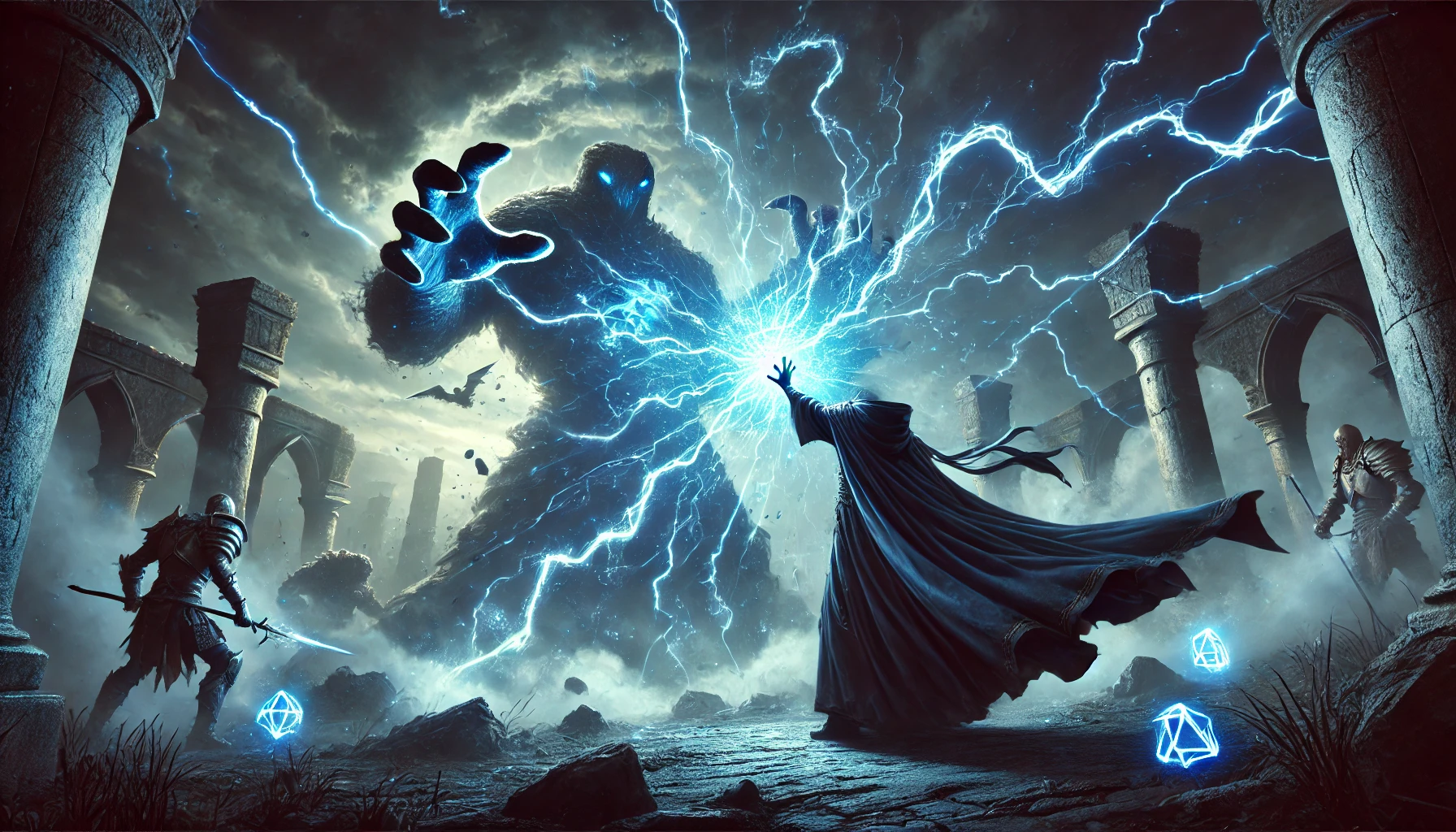Entertainment
Witch Bolt 5e: A Complete Guide to Mastering This Lightning Spell

Introduction
Overview of Witch Bolt in D&D 5e
Witch Bolt is a spell in Dungeons & Dragons 5th Edition (D&D 5e). It is a first-level evocation spell that allows players to unleash a continuous stream of lightning at their target. This spell connects the caster to the target with a crackling beam of energy, dealing consistent damage if the connection remains intact.
Witch Bolt stands out as a simple yet powerful choice for spellcasters who want to control a fight with sustained damage. The visual of the lightning beam makes it a popular option for players who enjoy dramatic and cinematic gameplay moments.
Purpose and Appeal of the Spell
Witch Bolt is designed for players who want to deal reliable damage over multiple turns without using extra spell slots. It is especially useful for locking onto a single target during combat. The spell’s lasting effect adds an exciting dynamic to battles, making it feel unique compared to one-off attack spells.
The appeal of Witch Bolt lies in its simplicity and effectiveness. It’s a great choice for beginners learning how to manage spells and for experienced players looking to experiment with concentrated damage tactics. Its combination of power and flavor makes it a favorite among many spellcasters in D&D 5e.
Spell Description
Casting Time, Range, Components, and Duration
- Casting Time: Witch Bolt requires 1 action to cast. This means you can use it during your turn without any preparation.
- Range: The spell has a range of 30 feet, so you need to be relatively close to the target to use it.
- Components: It requires verbal (V), somatic (S), and material (M) components. The material component is a twig from a tree struck by lightning, which is easy to roleplay or substitute with an arcane focus.
- Duration: The spell lasts for up to 1 minute, as long as you maintain concentration. This allows you to deal damage over several turns, provided the connection remains unbroken.
Detailed Explanation of Spell Mechanics
When you cast Witch Bolt, you make a ranged spell attack against a single creature within range. If the attack hits, the target takes 1d12 lightning damage immediately. After the initial hit, the spell maintains a connection between you and the target through a visible arc of lightning.
As long as the target stays within range and you maintain concentration, you can use your action on subsequent turns to deal 1d12 lightning damage automatically. You do not need to roll another attack after the first hit. This automatic damage can make Witch Bolt a consistent choice for sustained damage in combat.
- Critical Detail: If the target moves out of range (30 feet) or takes cover that breaks the line of sight, the spell ends.
- Scaling with Higher Levels: When cast using a spell slot of 2nd level or higher, the initial damage and subsequent automatic damage increase by 1d12 for each spell slot level above 1st. For example, casting Witch Bolt at 3rd level allows you to deal 3d12 lightning damage on every hit.
This makes Witch Bolt a versatile option for both low-level encounters and higher-level battles when you have access to stronger spell slots. It is most effective when you can keep the target within range and uninterrupted for several rounds.
Damage and Scaling
Initial Damage and Progression with Higher-Level Slots
When you cast Witch Bolt at its base level, the spell deals 1d12 lightning damage on a successful hit. This damage is immediate and repeated for as long as you maintain concentration, allowing you to deal consistent damage without additional attack rolls.
The damage increases when you cast Witch Bolt using higher-level spell slots:
- At 2nd level, the initial and subsequent damage increases to 2d12.
- At 3rd level, the damage increases to 3d12, and so on. This scaling makes Witch Bolt a strong option when facing tougher enemies, as each turn of automatic damage can add up quickly when the spell is cast with higher-level slots.
However, it’s important to note that Witch Bolt only works against a single target, so while the scaling makes the spell more powerful, it remains limited to one enemy at a time.
Comparison with Other 1st-Level Damage Spells
When comparing Witch Bolt to other 1st-level damage spells, it stands out for its sustained damage potential, but it also has specific drawbacks. Here’s how it measures up against similar spells:
- Magic Missile:
Magic Missile guarantees damage without needing an attack roll, dealing 1d4+1 damage per dart. While the damage is spread across multiple darts, it doesn’t sustain like Witch Bolt. Magic Missile is better for consistent hits and versatility, especially when targeting multiple enemies. - Chromatic Orb:
Chromatic Orb deals 3d8 damage of your chosen type (lightning, fire, cold, etc.) with a single attack roll. While its damage is higher initially, it does not continue over multiple turns like Witch Bolt. Chromatic Orb is a great burst damage spell but lacks the ongoing impact of Witch Bolt. - Guiding Bolt:
Guiding Bolt deals 4d6 radiant damage and grants advantage to the next attack against the target. While its damage is higher than Witch Bolt’s initial hit, it is a one-use spell. Witch Bolt, on the other hand, offers long-term value in drawn-out combat.
Strengths of Witch Bolt:
- Consistent, automatic damage after the first hit.
- Scales well with higher-level spell slots.
- Strong against enemies that can’t easily move or break line of sight.
Weaknesses of Witch Bolt:
- Requires concentration, which can be interrupted.
- Limited range of 30 feet.
- Vulnerable to enemies moving out of range or behind cover.
Witch Bolt excels when you can maintain the connection uninterrupted and benefits from its scaling mechanics, making it a viable choice for sustained single-target damage over time.
Tactical Applications
Ideal Combat Scenarios for Using Witch Bolt
Witch Bolt shines in specific combat situations where you can maximize its sustained damage and minimize its limitations. Here are the best scenarios for using Witch Bolt:
- Against Stationary or Slow Targets:
Witch Bolt is highly effective against enemies that don’t move much, such as large creatures or those bound by environmental factors. If the target has low mobility or is restrained, it’s easier to maintain the connection. - In Small, Confined Areas:
When fighting in tight spaces, such as dungeons or enclosed rooms, it becomes harder for enemies to escape the 30-foot range of Witch Bolt. This makes it easier to keep the connection active for multiple turns. - When You Need Sustained Damage:
Witch Bolt is perfect for longer battles where consistent damage over time is valuable. It’s especially useful for locking down a single high-priority target, such as a spellcaster or boss, while other party members handle smaller threats. - Enemies with Vulnerability to Lightning:
Against creatures vulnerable to lightning damage, such as certain water-based or metallic enemies, Witch Bolt becomes even more impactful.
Synergies with Other Spells and Abilities
Witch Bolt becomes more versatile and effective when combined with complementary spells and abilities. Here are some synergies to consider:
- Control Spells:
Use spells like Entangle, Hold Person, or Web to restrain enemies and prevent them from escaping Witch Bolt’s range. This ensures you can maintain the connection and deal damage for multiple turns. - Debuff Spells:
Spells like Hex or Bane can weaken the target, making it harder for them to break line of sight or disrupt your concentration. Hex is particularly useful, as it also adds damage to your attacks. - Concentration Boosting Abilities:
If you’re playing a Sorcerer, the War Caster Feat can help you maintain concentration on Witch Bolt even when taking damage. Warlocks with the Eldritch Invocation: Aspect of the Moon or a similar feature can also enhance their concentration capabilities. - Team Synergy:
Party members can support your Witch Bolt strategy by keeping the target within range. For instance, a melee fighter could engage the enemy in close quarters, or a druid could cast Spike Growth to slow down movement. - Higher-Level Spell Combos:
Combine Witch Bolt with area-control spells like Wall of Force or Blade Barrier to trap enemies within range. This allows you to deal consistent damage without interruption.
By choosing the right scenarios and combining Witch Bolt with supportive spells and abilities, you can maximize its effectiveness in combat. These tactical applications make it a reliable choice for players looking for sustained damage and strategic gameplay.
Limitations and Drawbacks
While Witch Bolt offers consistent and sustained damage, it comes with several limitations that players need to consider when deciding to use the spell. Understanding these drawbacks can help you use Witch Bolt effectively in the right situations.
Concentration Requirements and Potential Disruptions
Witch Bolt requires concentration to maintain the connection to the target. This means that any damage you take while concentrating on the spell forces you to make a Constitution saving throw to maintain it. If you fail the save, the spell ends immediately, and the connection is lost.
- Risk from Damage: Enemies that focus on attacking you can disrupt your concentration. Area-of-effect spells, ranged attacks, or melee combatants targeting you can make it challenging to keep the spell active.
- Limited Actions: Since Witch Bolt requires your action to deal damage each turn, you cannot use your action for other offensive spells or abilities while maintaining the spell.
- Counterspells and Dispels: Enemy spellcasters can use Counterspell to prevent you from casting Witch Bolt or Dispel Magic to end the spell after it’s cast.
To mitigate these issues, consider using defensive spells like Shield or Mage Armor to reduce damage taken, or rely on teammates to protect you during combat.
Challenges with Maintaining Range and Line of Sight
Witch Bolt’s effectiveness depends on keeping the target within its 30-foot range and maintaining line of sight throughout the duration of the spell.
- Short Range: The 30-foot range requires you to be fairly close to the target, which can be risky for squishy spellcasters like wizards and sorcerers. If the target moves out of range, the spell ends immediately.
- Line of Sight Issues: If the target moves behind cover, into darkness, or around a corner where you can no longer see them, the spell’s connection breaks. Enemies with teleportation abilities or high mobility can easily escape the beam.
- Environmental Hazards: Terrain features like walls, fog, or magical darkness can block line of sight and disrupt the spell.
To overcome these challenges:
- Use spells like Fog Cloud or Darkness strategically to control enemy movement and keep them within range.
- Work with teammates to restrict the target’s movement, such as grappling them or using spells like Entangle.
- Position yourself carefully to minimize the chance of enemies breaking the connection.
Witch Bolt’s limitations make it less versatile than other damage spells, but understanding these drawbacks allows you to use it more effectively. Proper positioning, teamwork, and planning can help you avoid these pitfalls and make the most of this unique spell.
Class Synergies
Witch Bolt is available to Sorcerers, Warlocks, and Wizards, and its effectiveness varies depending on the class and subclass. Each brings unique abilities and features that can enhance the utility of the spell. Here’s how Witch Bolt works for these spellcasting classes.
Effectiveness for Sorcerers, Warlocks, and Wizards
- Sorcerers:
Sorcerers excel at making Witch Bolt more versatile thanks to their Metamagic abilities. Features like Twinned Spell can allow you to target two creatures with Witch Bolt simultaneously, effectively doubling its output. Sorcerers also have access to spells like Shield and Absorb Elements, which can protect them while maintaining concentration on Witch Bolt. - Warlocks:
Witch Bolt can align well with the Warlock’s spellcasting mechanics, especially since Warlocks regain spell slots after a short rest. When cast at higher levels, Witch Bolt becomes a consistent and powerful option for Warlocks in drawn-out battles. Warlocks with the Hexblade Pact can combine Witch Bolt with Hex, adding additional damage every turn. The Agonizing Blast invocation, while typically paired with Eldritch Blast, can complement Witch Bolt if you alternate spell choices. - Wizards:
Wizards benefit from their vast spellbook and support spells that can enhance Witch Bolt’s effectiveness. They can prepare defensive and control spells like Hold Person, Mage Armor, or Shield, which help maintain concentration. Wizards also have the advantage of more spell slots, allowing them to cast Witch Bolt at higher levels when needed.
Subclass Features That Enhance Witch Bolt
- Sorcerer Subclasses:
- Storm Sorcery: This subclass pairs beautifully with Witch Bolt. The thematic lightning damage fits well, and abilities like Heart of the Storm allow you to deal additional lightning or thunder damage to nearby enemies when casting Witch Bolt. Storm Guide also improves mobility, helping you maintain range and line of sight.
- Draconic Bloodline: If your chosen dragon ancestry is tied to lightning damage, Witch Bolt can gain a thematic and mechanical boost. The subclass’s increased hit points also help maintain concentration.
- Warlock Subclasses:
- Hexblade: The Hexblade’s focus on single-target combat aligns well with Witch Bolt. Adding Hex on top of Witch Bolt deals extra necrotic damage with every automatic hit.
- The Fiend: Fiend Warlocks gain temporary hit points when they reduce a creature to 0 HP, making them slightly more durable for maintaining concentration on Witch Bolt.
- Wizard Subclasses:
- Evocation Wizard: The Sculpt Spells feature allows you to safely use Witch Bolt in combat with allies nearby. This subclass also boosts damage output through Empowered Evocation, adding extra points of damage based on your Intelligence modifier.
- Divination Wizard: The Portent feature can ensure your Witch Bolt attack roll succeeds by replacing it with a favorable die roll, increasing the spell’s reliability.
Witch Bolt is most effective when paired with subclasses and features that complement its single-target focus, lightning damage theme, and need for concentration. By choosing the right class and subclass, players can unlock its full potential and create memorable moments in their D&D 5e campaigns.
Player Tips and Strategies
Using Witch Bolt effectively requires careful planning and smart decisions during combat. Here are some tips and strategies to maximize its damage output and ensure it’s used in the right situations.
Maximizing Damage Output and Efficiency
- Cast at Higher Levels: Whenever possible, use higher-level spell slots to boost Witch Bolt’s damage. Each additional level adds 1d12 lightning damage, making it a powerful option for sustained damage against tough opponents.
- Use Synergies to Boost Damage: Pair Witch Bolt with abilities or spells that enhance its damage:
-
- Hex (Warlock): Add 1d6 necrotic damage to every automatic hit of Witch Bolt.
- Metamagic (Sorcerer): Use Twinned Spell to hit two targets or Empowered Spell to reroll low damage dice.
- Spell Scaling Features: Subclasses like Evocation Wizards or Storm Sorcerers can add damage modifiers or deal additional lightning-based damage.
- Protect Concentration: Maintaining concentration is critical for Witch Bolt’s effectiveness. Use spells like Mage Armor or Shield to protect yourself. Consider taking the War Caster feat to make concentration-saving throws easier during combat.
- Position Wisely: Stay at the edge of Witch Bolt’s range (30 feet) to minimize the risk of being hit while maintaining the connection. Use terrain or cover to stay safe while targeting your enemy.
Situational Awareness and Target Selection
- Choose the Right Target: Witch Bolt is most effective against enemies that are:
-
- Stationary or Slow: Targets that don’t move much or are restrained (by spells like Entangle or Hold Person) are ideal.
- High Priority: Use Witch Bolt on dangerous enemies like spellcasters or bosses that you want to lock down with consistent damage.
- Avoid Fast or Teleporting Enemies: Creatures with high mobility or teleportation abilities can easily break Witch Bolt’s connection. Save the spell for enemies less likely to move out of range or behind cover.
- Control the Battlefield: Work with your team to limit the target’s movement. Allies can help by grappling the enemy, using spells like Spike Growth to slow them, or blocking escape routes.
- Watch for Line of Sight: Enemies can break Witch Bolt’s connection by moving behind cover or out of view. Position yourself carefully to maintain line of sight and minimize disruptions.
By focusing on proper positioning, target selection, and damage-boosting strategies, you can make the most of Witch Bolt’s unique mechanics. It’s a spell that rewards careful planning and teamwork, offering a consistent and satisfying way to deal damage in combat.
Dungeon Master Considerations
As a Dungeon Master (DM), understanding how Witch Bolt functions can help you create balanced encounters and adapt the spell to fit your campaign setting. While the spell has its strengths, its limitations can create unique challenges and opportunities for both players and enemies.
Balancing Encounters Involving Witch Bolt
- Highlight the Strengths: Witch Bolt is ideal for sustained single-target damage. Design encounters where the spell’s utility can shine, such as battles with strong, stationary enemies or enemies that benefit from being locked down over multiple turns.
- Play to the Weaknesses: Incorporate enemies or environmental challenges that expose the spell’s limitations:
-
- Use fast or mobile enemies that can break the connection by leaving the 30-foot range.
- Introduce enemies with abilities like teleportation or flight, which make it difficult for players to maintain line of sight.
- Add creatures with high mobility or terrain advantages to challenge players relying on Witch Bolt.
- Avoid Overwhelming Players: Since Witch Bolt requires concentration, avoid overwhelming the caster with too many enemies targeting them directly. Allow them opportunities to benefit from their spell without losing it every turn due to failed concentration checks.
Adapting the Spell for Unique Campaign Settings
- Introduce Unique Witch Bolt Variants: Modify Witch Bolt to match the theme of your campaign. For example:
-
- In a fire-themed campaign, replace the lightning damage with fire damage and describe the beam as a searing flame.
- In an arcane-focused world, make Witch Bolt more magical by giving it additional visual effects, such as glowing runes along the lightning arc.
- Custom Environmental Interactions: Add environmental factors that interact with Witch Bolt. For example:
-
- In a stormy setting, using Witch Bolt could amplify its damage when used near a source of electricity.
- In an underwater setting, lightning damage could deal additional damage to nearby creatures within a certain radius, making it more dangerous for both friend and foe.
- Adjust Scaling for Homebrew Campaigns: If your campaign involves more powerful enemies at earlier levels, consider allowing Witch Bolt to scale differently. For example, allow players to add an additional die of damage after a set number of turns maintaining the connection.
By understanding Witch Bolt’s mechanics and tailoring encounters to showcase both its strengths and weaknesses, DMs can create dynamic and balanced gameplay. Adapting the spell to fit unique campaign settings can also provide players with a memorable experience while keeping the spell relevant throughout the adventure.
Community Feedback and Variants
The D&D community has a lot to say about Witch Bolt, with players often sharing creative homebrew modifications and personal experiences to make the spell more impactful. Here’s a look at how the community views Witch Bolt and how they’ve adapted it for unique gameplay.
Popular Homebrew Modifications and Improvements
Witch Bolt has inspired many homebrew tweaks to address its limitations and enhance its utility. Here are some of the most popular modifications:
- Increased Range:
Many players feel the 30-foot range is too short for a spellcaster. A common homebrew tweak increases the range to 60 feet, allowing for safer positioning and better usability. - Slight Damage Buffs:
To make Witch Bolt more competitive with other 1st-level damage spells, some DMs allow the spell to deal 1d12 damage on the initial hit and 2d12 on subsequent turns if concentration is maintained. - Free Movement with the Beam:
A common complaint is the difficulty of maintaining line of sight. Some homebrew rules allow the beam to persist even if the target moves out of line of sight temporarily, as long as the caster can reestablish sight within their turn. - Lightning Arc Effect:
Homebrew variants include adding an area-of-effect component where nearby creatures within 5 feet of the target take half damage from the lightning arc, making the spell more versatile in multi-enemy encounters. - Reduced Concentration Restrictions:
Some DMs allow players to maintain Witch Bolt without losing it if the target breaks range but re-enters range within one turn. This makes the spell less punishing while still retaining its tactical nature.
Player Experiences and Testimonials
Witch Bolt is a divisive spell, with players sharing mixed opinions about its effectiveness in gameplay. Here are some notable insights from the community:
- Positive Experiences:
-
- Many players enjoy Witch Bolt for its thematic appeal, describing the spell as visually stunning and cinematic.
- Players who favor sustained single-target damage often find the spell satisfying, especially when paired with control spells like Hold Person to keep the target restrained.
- Sorcerers, in particular, love combining Witch Bolt with Twinned Spell, allowing them to hit two targets simultaneously for massive damage.
- Critical Feedback:
-
- Common complaints include the short range and the need for concentration, which makes the spell vulnerable to disruptions.
- Players often compare Witch Bolt unfavorably to spells like Magic Missile or Chromatic Orb, which provide more flexibility or higher burst damage.
- Some players feel the spell is more viable at lower levels but becomes obsolete as campaigns progress and other spells become available.
Why These Variants Matter
The community’s homebrew modifications and feedback show that while Witch Bolt has its shortcomings, there’s potential to make it a more engaging and versatile spell. DMs and players can tweak the spell to fit their playstyle and campaign needs, ensuring it remains relevant and enjoyable.
Conclusion
Witch Bolt is a unique and visually stunning spell in D&D 5e, offering consistent single-target damage with a strong thematic appeal. Its strengths lie in its sustained lightning damage and scalability when cast with higher-level spell slots. The spell is most effective against stationary or slow-moving enemies and becomes even more powerful when paired with control spells or abilities that enhance its impact. However, Witch Bolt’s short range, reliance on concentration, and vulnerability to line-of-sight disruptions make it situational. These limitations require careful planning and smart positioning to maximize its potential.
Incorporating Witch Bolt into your gameplay can lead to exciting and cinematic combat moments, especially in the hands of creative players and Dungeon Masters. Whether you’re using the spell in its original form or with homebrew modifications, Witch Bolt can add a dynamic layer to encounters. It’s a spell that rewards strategy and teamwork, making it a valuable tool for those who embrace its strengths and navigate its challenges thoughtfully.
Thank you for visiting our blog! If you enjoyed this post, feel free to check out more interesting and helpful content here.
-

 Law & Personal Injury6 days ago
Law & Personal Injury6 days agoHow to File a Sample Complaint for Sanctions Against an Attorney in Illinois
-

 Fashion1 week ago
Fashion1 week agoWhat are the Differences Between Microlocs vs Sisterlocks?
-

 Entertainment6 days ago
Entertainment6 days agoKamryan Randolph Wrestling: The Journey of a Rising Star in Sports
-

 Entertainment1 week ago
Entertainment1 week agoAura of Vitality 5e: A Complete Guide to Healing and Support in Combat
















